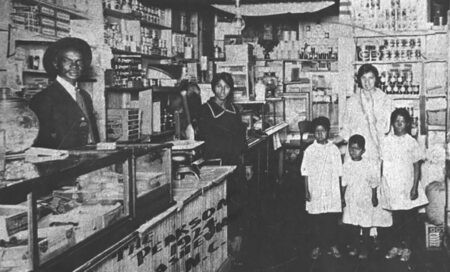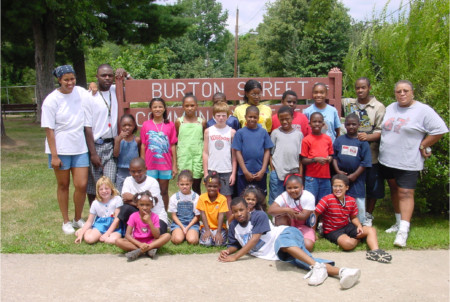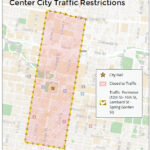“Plant early, dig in now! Plant and hoe, make that garden grow. Plant it, work it, day and night; So when the winter snow is falling, you will be sure to eat right.”
This inspiring slogan, coined by civic leader Edward W. Pearson Sr., resonates deeply with the story of Burton Street in Asheville. More than just a neighborhood, Burton Street blossomed from the seeds of Pearson’s vision, nurturing a strong community centered around what was once the Burton Street School.
E.W. Pearson: The Visionary of Burton Street
Born in Glen Alpine in 1872, Edward W. Pearson Sr. was a man of remarkable ambition and dedication. After serving with the Buffalo Soldiers, the distinguished 9th Cavalry unit of the U.S. Army, Pearson arrived in Asheville in 1906. His experience in real estate, gained in Chicago, proved invaluable as Asheville entered a period of significant growth. Recognizing an opportunity, Pearson established Park View, Asheville’s first subdivision specifically for Black families. This area, now known as Burton Street (originally Buffalo Street), became a testament to his vision and commitment to community development.
Park View initially stretched to Westwood Place and consisted of spacious, wooded lots. This attracted tenant farmers from across the Carolinas and neighboring states who sought to own land and build their own small farms. Many found employment in Asheville’s growing sectors, including construction, tourism, and domestic service, while establishing their roots in Park View. As the population grew, Burton Street evolved into a vibrant neighborhood with its own streets, churches, businesses, and, crucially, a school.
Pearson’s community-building efforts extended beyond real estate. In 1913, he launched the Buncombe County District Agricultural Fair at Pearson’s Park on Fayetteville Street. This annual event became a major attraction for Black residents throughout Western North Carolina, featuring agricultural exhibits, parades, amusement rides, and games. Pearson awarded cash prizes for excellence in agriculture, crafts, baking, sewing, and floral arrangements, fostering community pride and showcasing local talent.
Beyond the fair, Pearson founded the Royal Giants baseball team in 1916, providing entertainment and community spirit by competing with other semi-professional Black teams from the region at Pearson’s Park and Oates Park. His entrepreneurial spirit led him to establish several businesses, including Mountain City Mutual Insurance Co. and Piedmont Shoe Co., a mail-order venture. Driven by a desire to uplift Asheville’s Black community, Pearson also founded the first business league for Black businessmen in the city and established the local chapter of the NAACP, demonstrating his multifaceted leadership and dedication to progress.
 E.W. Pearson's Grocery Store, Burton Street Asheville, a community hub with a jukebox and meeting space.
E.W. Pearson's Grocery Store, Burton Street Asheville, a community hub with a jukebox and meeting space.
Pearson also ran the E.W. Pearson Grocery Co., which became a central gathering place for the community. More than just a store, it featured a large room for social events, a Piccolo jukebox, a pool table, and even a playground with swings and a merry-go-round. The Pearson family regularly hosted concerts and gatherings at the store and their home nearby, with Pearson himself, a skilled musician, performing with his children.
Following E.W. Pearson Sr.’s passing in 1946, his son, E.W. Pearson Jr., transformed the former grocery store into the Blue Note Casino, a music club that became a popular entertainment venue located across from the present-day Burton Street Community Center.
Burton Street School: Educating a Community
The building now housing the Burton Street Community Center has a rich history, originally constructed in 1928 as Burton Street School. However, the site’s educational legacy dates back to 1916 when a smaller, two-room schoolhouse opened as a branch of Buncombe County Schools. Significantly, the land itself was designated for a school for Black students as early as 1884. Hattie H. Love, a dedicated educator, was among the early teachers, later becoming principal and serving as secretary of the NAACP state conference, highlighting the school’s connection to community leadership and civil rights.
 Burton Street School students and teacher Gertrude D. Jones, Asheville, North Carolina, circa 1954.
Burton Street School students and teacher Gertrude D. Jones, Asheville, North Carolina, circa 1954.
The original Burton Street School accommodated around 120 students, with classes divided into morning and afternoon sessions for different grade levels. The construction of the larger building in 1928, featuring four classrooms, an auditorium, lunchroom, and library, allowed for full-day schooling. Burton Street School served as the primary educational institution for the neighborhood’s children before they progressed to Hill Street School for middle grades.
Beyond academics, Burton Street School played a vital role in community life. In 1950, recreation programs were introduced under the supervision of Isaiah Rice and Mrs. C. W. James, offering activities like group singing, dramatics, games, and table games. The school’s role as a community hub continued until its closure in 1965 as part of Asheville City Schools’ desegregation plan. In 1977, the building was deeded to the City of Asheville, paving the way for its future as a community center.
Community Resilience: Neighbors, Not Borders
The Burton Street neighborhood faced significant challenges in the latter half of the 20th century. The construction of Smoky Park Bridge (now Capt. Jeffrey Bowen Bridge) in the late 1950s and I-240 in the 1960s dramatically altered the neighborhood’s landscape. Patton Avenue’s westward extension cut through natural areas, while I-240 further bisected the community, creating dead-end streets, displacing families, and isolating areas like Argyle Lane.
Despite these physical divisions, the spirit of Burton Street’s community remained resilient. On April 1, 1963, E.W. Pearson’s former store building was officially established as the Burton Street Community Center. Pearson’s daughter, Iola Byers, affectionately known as “Miss Iola,” was appointed as the center’s director, a role she held until 1992. Byers, who was also the first Black woman to become a deputy with the Buncombe County Sheriff’s Office, deeply cherished her father’s legacy and the Burton Street community. She was known for her innovative ideas and dedication to providing engaging programs and entertainment for all ages.
As Asheville Parks & Recreation expanded its services through federal grants in the 1970s, the community center relocated to the larger 1928 school building. Renovations transformed the space to include a kitchen, sewing room, fitness center, billiards room, meeting spaces, and accessible restrooms. Despite these improvements, the building required significant repairs, including a new roof, updated electrical systems, and replacements for doors, windows, floors, and walls.
The Burton Street Community Center became more than just a recreation facility; it served as a vital space for neighborhood meetings, social gatherings, and a safe haven for children, especially before the establishment of formal after-school programs. In a 1983 Asheville Citizen-Times article, Byers highlighted the center’s crucial role in supporting working mothers and addressing community needs, emphasizing its function as an information hub and a place where personal connections allowed for a deep understanding of residents’ challenges.
Burton Street Revival: A Community Rejuvenated
The 1980s and 1990s brought demographic shifts to Burton Street. As original families moved away or passed on, homes were often left vacant, sold, or rented to newcomers. While the Community Center adapted by adding nutrition programs and computer access, the weakening of the once-tight community fabric contributed to increased crime and drug activity in the area.
 Burton Street Community Center sign, reflecting community spirit and local programs in Asheville.
Burton Street Community Center sign, reflecting community spirit and local programs in Asheville.
Residents felt increasingly underserved by city government, except for the programs offered at the Burton Street Community Center. A pivotal moment arrived in 1996 when a City Council decision to allow storage units in a residential part of the neighborhood ignited a new wave of community activism. The Community Center became the central meeting place for organizing efforts. Working alongside the Asheville Police Department to combat crime, residents began developing a master plan to guide the future of their community.
When Asheville Parks & Recreation presented its first comprehensive master plan in 1998, significant investments in the Burton Street Community Center were prioritized. Although a public bond referendum to fund these improvements failed narrowly in 1999, the public dialogue generated was impactful. City Council subsequently approved a property tax increase, allocating a portion to community center upgrades, sports fields, and green space improvements.
Despite economic challenges in 2001, Burton Street residents persevered, advocating for their Community Center and celebrating the installation of a new playground. Through the neighborhood-focused Weed and Seed program, further renovations and upgrades were made to the center to accommodate expanded services, demonstrating the community’s unwavering commitment to revitalization.
Burton Street Today and Beyond: A Legacy Continues
 Burton Street Agricultural Fair revival in 2012, celebrating community heritage and E.W. Pearson's legacy.
Burton Street Agricultural Fair revival in 2012, celebrating community heritage and E.W. Pearson's legacy.
E.W. Pearson’s enduring presence in Burton Street is visually represented by a mural at the community center, unveiled during the revived Burton Street Agricultural Fair in 2012. This serves as a constant reminder of the neighborhood’s rich history. Since the 1990s, another highway project has posed a threat to the community, but in 2018, City Council unanimously approved a plan presented by the Burton Street Neighborhood Association to enhance the community center, improve pedestrian infrastructure, and implement other revitalization measures in partnership with residents.
Recent additions, like solar panels on the community center, and planned substantial park renovations, signal a commitment to meeting the evolving needs of Burton Street.
Iola Byers’ words beautifully encapsulate her father’s enduring legacy and the spirit of Burton Street: “I can just see him, standing back, his arms folded, being so proud of all this progress. Little kids can’t go far from home and if you can provide this within a community, that is good. He’d be so proud to see all this.”
Do you have photos or stories to share about Burton Street Community Center? Please send them to [email protected] so APR can be inspired by the past as we plan our future.
Photo and Image Credits
- The community center’s refreshed brick exterior and mural of E.W. Pearson, along with the surrounding park featuring a playground, community garden, and basketball courts.
- A 1912 plat map illustrating Pearson’s Park View development, highlighting the original vision for Burton Street and its surroundings. Courtesy of Buncombe County Special Collections, Pack Memorial Public Library.
- Inside E.W. Pearson’s Grocery Store in 1924, showcasing E.W. Pearson Sr., clerk Ruth Terry, Annis Bradshaw Pearson, and their children, a glimpse into Burton Street’s social and commercial heart. Photo courtesy of Clifford W. Cotton II and Buncombe County Special Collections, Pack Memorial Public Library.
- Burton Street School fifth and sixth graders with teacher Gertrude D. Jones, circa 1954, capturing a moment in the school’s educational history. Photograph by Clifford Cotton II. Courtesy of Buncombe County Special Collections, Pack Memorial Public Library.
- “Miss Iola” Byers, Burton Street Community Center director from 1963-1992, a dedicated community leader featured in the Asheville Citizen-Times in 1983.
- The original Burton Street Community Center sign, symbolizing its long-standing role as a safe and supportive space for the neighborhood.
- Burton Street Agricultural Fair revival in 2012, a community celebration honoring E.W. Pearson’s legacy and Burton Street’s agricultural heritage.

